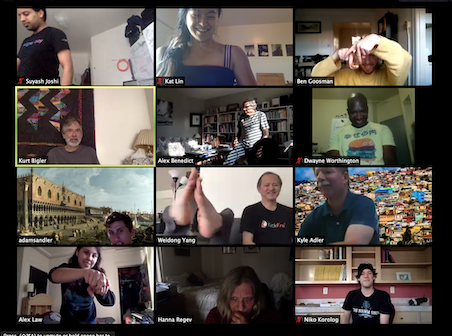As the rest of the United States descends further into a dystopian hellscape of unchecked viral spread, we here at Kinetech Arts still gather weekly to soothe our quarantine blues and to Make Some Art and Explore Some Concepts!
For those of you unfamiliar with us, here’s a quick recap of how Open Lab went on July 22.
At 6 pm PST, our crew of 13 Open Labbers convened on Zoom.
We start off every week with Menti as a little icebreaker question set. My personal favorite question and set of answers -- If a movie was made of our Open Lab attendees’ lives, what genre would it be, and who would play you? There’s an array of answers as to movie genres, but in all honesty, a movie of Kinetech Arts would likely be experimental comedy and I think everyone would play each other.
But we quickly moved onto grander philosophical explorations!
The Concepts:
The focus of this July 22 Open Lab was inspired by a particular factoid about “gestures” -- namely, that specific gestures seem to develop innately and specific to particular languages. For example, a well-cited 1998 Nature paper authored by psychology professors Jana Iverson and Susan Goldin-Meadow found that congenitally blind speakers gesture despite their lack of a visual model, even when they speak to a blind listener. Additionally, the frequency and types of gestures blind speakers use are very similar to sighted speakers -- which means that gesturing must be part of the language-learning process.
A 2016 paper by Şeyda Özçalışkan, Ché Lucero and Susan Goldin-Meadow studied this gesturing phenomenon further still by observing how blind Turkish and English speakers used gestures. The objective was to delineate whether how the blind participants gesture is different from the way sighted speakers of those languages. It’s established that blind people gesture -- so do they gesture the way other speakers of the same language do?
It’s been established (perhaps not to the public, but to linguists) that when shown a video of an item moving, English speakers are more likely to show the manner (e.g. ‘rolling’ or bouncing’) and trajectory (e.g. ‘left to right’, ‘downwards’) together in one gesture. On the other hand, Turkish speakers tend to show those features as two separate gestures. This is because in English, ‘roll down’ is one verbal clause together, but the Turkish counterpart, yuvarlanarak iniyor, actually translates as two verbs ‘rolling descending’.
So, would blind Turkish speakers separate the manner and trajectory in their gestures as speakers of Turkish do their verbs? Do English speakers tend to combine?
Tldr; yes.
The ultimate conclusion is that our gestural patterns are actually quite deeply linked to grammatical properties of a language. You don’t learn gestures from looking at other speakers.
So, with that in mind, Ben Goosman and Wei Dong wondered, how can we explore this concept?
The Experiment of the Week:
Ben Goosman came up with the following prompt to poke around at this phenomenon.
“Choose one verb of pull, push, yank, fidget, flap, gyrate, kick, rock, squirm, sway, twitch, wiggle, bounce, drift, drop, float, glide, move, roll, slide, swing. Choose one preposition: above, across, against, along, among, around, at, before, behind, below, beneath, beside, between, by, down, from, in, into, near, of, off on, to, toward, under, upon, with and within. One person in the group says their chosen verb + preposition.
After 3 seconds, everyone performs a gesture signifying that verb. Everyone takes a turn. How many distinct gestures did you use? Can you combine both words into one gesture or does it make more sense to you to use two or more?”
With a “Wiggle Towards” and a smattering of other combinations of verbs and prepositions, we found that many people actually did often have similar gestures of verbs -- and we all did tend to combine them as one movement. Unsurprising, given that we were English speakers.
We explored in small breakout groups of three and as a crowd of 13.
Interesting too, was the concept of where we directed the prepositions. While most people wiggled “towards” their cameras given the prompt “wiggle towards”, a few people would wiggle towards other objects. What does that say about us?
Certainly, we’ve left much room to experiment with even more anthropological linguistics.
The Finisher:
Our latest Kinetech Art Open Lab quarantine experiment is with the weekly Jam Board, a collaborative document where we post quotes, photos, draw, and just jam with each other visually as we jam with each other by dancing as well.
And then we continued to dance and gyrate and kick and squirm across the Zoom gallery view. If you care to join us, feel free to join our meetup group here and pop on by between 6-7:15 PM Pacific time!
Further reading:
Jana M. Iverson & Susan Goldin-Meadow. 1998. Why people gesture when they speak. Nature, 396(6708), 228-228.
Şeyda Özçalışkan, Ché Lucero and Susan Goldin-Meadow. 2016. Is Seeing Gesture Necessary to Gesture Like a Native Speaker? Psychological Science 27(5) 737–747.
Asli Ozyurek & Sotaro Kita. 1999. Expressing manner and path in English and Turkish: Differences in speech, gesture, and conceptualization. In Twenty-first Annual Conference of the Cognitive Science Society (pp. 507-512). Erlbaum.

